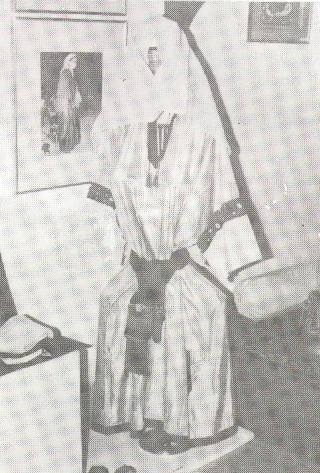Kashmiri Pandit Costume
Literary and archaeological
evidence shows that in ancient and medieval
times
the costume of the Kashmiri
male consisted essentially of a lower
 garment, an upper garment and a turban.
If Kashmiri sculpture is any guide, men as well as women wore a long tunic
and trousers, probably due to Kushana influence. According to Hieun Tsang,
they dressed themselves in leather doublets and clothes of white linen.
In winter, however they covered their body with a warm cloak which the
Nilamata Purana calls Pravarana. The rich among them were also draped in
fine woollen shawls while the ordinary people had to rest content with
cheaper woollen articles like the coarse sthulkambala.
garment, an upper garment and a turban.
If Kashmiri sculpture is any guide, men as well as women wore a long tunic
and trousers, probably due to Kushana influence. According to Hieun Tsang,
they dressed themselves in leather doublets and clothes of white linen.
In winter, however they covered their body with a warm cloak which the
Nilamata Purana calls Pravarana. The rich among them were also draped in
fine woollen shawls while the ordinary people had to rest content with
cheaper woollen articles like the coarse sthulkambala.
The use of different kinds of turbans known as
ushneek or shirahshata was widely prevalent. Strange though it may seen,
the dress of a woman in early Kashmir consisted mainly of sari and tailored
jackets or blouses. She is also shown wearing a long flowing tunic and
trousers. It was fashion for both men and women to braid their hair in
different styles, wearing sometimes tassels of varied colours.
It is, therefore, difficult to say how long back
in tradition does the present attire of Kashmiri Pandit males and females
go. Of course, in early Kashmir men and women both were fond of adorning
them selves with ornaments. They wore rings in the fingers, gold necklaces,
ear rings, armlets and wristlets and even amulets. The women also wore
anklets, bracelets, pearl-necklaces, pendants on the forehead and golden
strings at the end of the locks ( a forerunner of the attahor perhaps).
One thing is certain, the traditional dress of Kashmiri Pandits underwent
a definite change after the advent of Islam. Today the following articles
compose their attire:
A. Pheran
The long flowing dress called the pheran-pravarna
of the Nilamata Purana is traditionally worn by both Pandit males and females.
The dress is always worn in a pair, the underlayer called potsh, being
of light white cotton. In case of women, the pheran has wide sleeves, overturned
and fringed with brocaded or embroidered stripes. Similar long stripes
of red borders are attached around the chest- open collars (quarterway
down the front of shoulders and all along the skirt. A loongy, or a coloured
sash was tied round the waist.
The traditional male garment is always plain and
has narrow sleeves and a leftside breast-open collar with a kind of lapel
or lace emerging from it.
B. Women's Headgear: Taranga
Taranga or the female headgear is reminiscent
of the racial fusion of the Aryans and Nagas to which the Nilamata Purana
has referred. It symbolizes the decorative hood of the crelestial serpent
(nag) with a flowing serpentine body tapering into a double tail almost
reaching the heels of the wearer. It is composed of the following parts:
Taranga - The elements for composition
of the Headgear:
a) Kalaposh - the cap, a conic shape of
decorative brocade or silken embroidery, attached with a wide and round
band of Pashmina in crimson, vermilion or scarlet. The conic shape would
cover the crown and the band would be shortened threefold around the forehead.
b) Zoojy - a delicate net-work cloth topped
by embroidery motifs, and worn over the crown of kalaposh and tapering
flowing down to the small of the back.
c) Taranga - it comprises of three narrow
and continuous wraps over and around the head, the final round having moharlath,
starched and glazed over with an agate-stone, crystal or a soft giant shell.
d) Poots - the two long lengths of fine
white muslin hemmed together longitudinally with a "fish spine" pattern.
Lengthwise, then the whole piece is rolled and wrapped inwards from both
sides so as to form the long bodies of a pair of snakes with a pair of
tapering tails at the lower end and a hood at the other end (top) to open
up and cover the apex of the headgear while flowing down over the back
almost touching the heels.
C. Men's Headgear:
The turban is the traditional headgear of the
Kashmiri Pandit males, though its use is very restricted now. This turban
is not much different from the turban the Muslims wear except that the
Pandits do not wear any scalp cap inside. The priest class among the Pandits
would wear their turbans in almost the Namdhari Sikh style.
Reproduced from:
Unmesh
An NSKRI Publication
|

